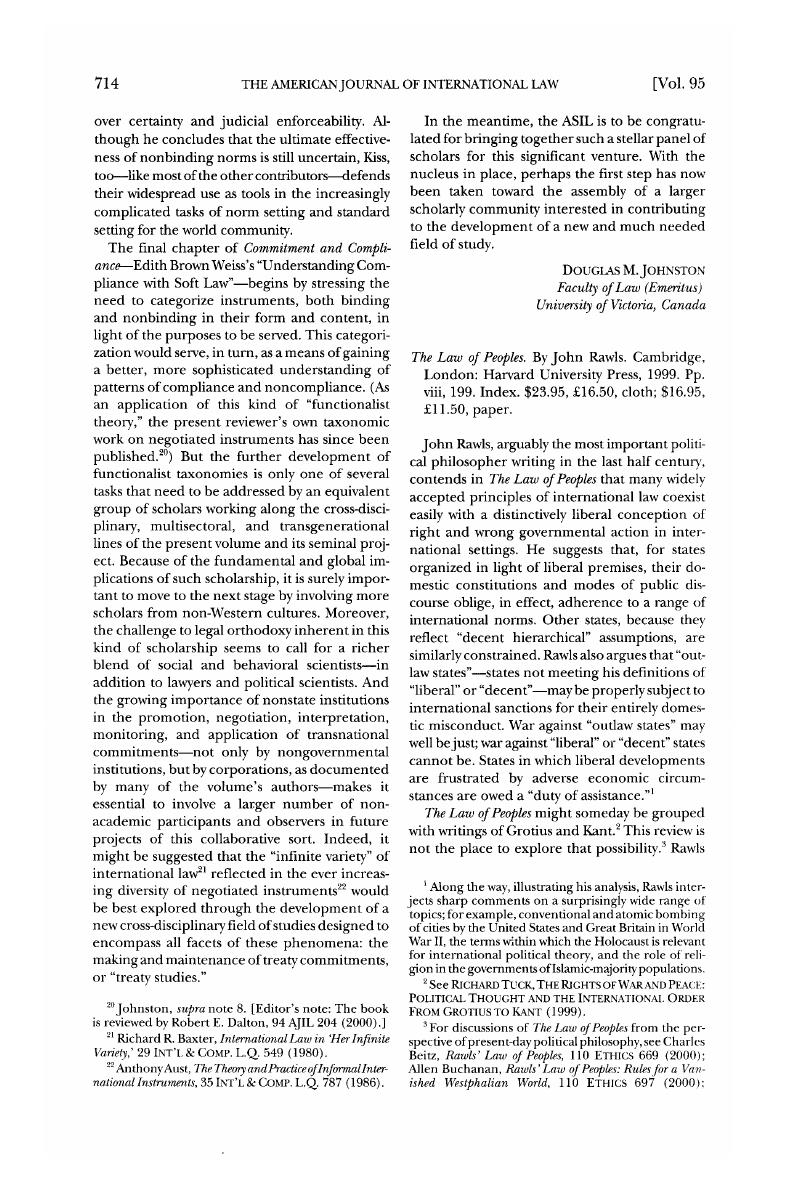Published online by Cambridge University Press: 06 June 2017

1 Along the way, illustrating his analysis, Rawls interjects sharp comments on a surprisingly wide range of topics; for example, conventional and atomic bombing of cities by the United States and Great Britain in World War II, the terms within which the Holocaust is relevant for international political theory, and the role of religion in the governments of Islamic-majority populations.
2 See Tuck, Richard, The Rights of War and Peace: Political Thought and The International Order From Grotius to Kant (1999)Google Scholar.
3 For discussions of The Law of Peoples from the perspective of present-day political philosophy, see Beitz, Charles, Rawls’ Law of Peoples , 110 Ethics 669 (2000)CrossRefGoogle Scholar; Buchanan, Allen, Rawls’ Law of Peoples: Rules for a Vanished Westphalian World , 110 Ethics 697 (2000)Google Scholar: Kuper, Andrew, Rawlsian Global Justice , 28 Political Theory 640 (2000)Google Scholar.
4 The first part elaborates and reworks an earlier essay, see Rawls, John, The Law of Peoples , in On Human Rights: The Oxford Amnesty Lectures (Shute, Stephen & Hurley, Susan eds., 1993)Google Scholar. The second part reproduces an article Rawls had also previously published. See Rawls, John, The Idea of Public Reason Revisited , 64 U. Chi. L. Rev. 765 (1997)CrossRefGoogle Scholar.
5 See also Raz, Joseph, The Morality of Freedom 38-69 (1986)Google Scholar.
6 Point of view—the possibility of differences in point of view—is thus a foundational premise for Rawls.
7 The now-classic statement of these propositions is Michael, W. Doyle, Kant, Liberal Legacies, and Foreign Affairs I & II , 12 Phil. & Pub. Aff. 205 & 323 (1983)Google Scholar.
8 Rawls also presents a fuller list, but again emphasizes limits:
Among the human rights are the right to life (to the means of subsistence and security); to liberty (to freedom from slavery, serfdom, and forced occupation, and to a sufficient measure of liberty of conscience to ensure freedom of religion and thought); to property (personal property); and to formal equality as expressed by the rules of natural justice (that is, that similar cases be treated similarly). (P. 65, footnotes omitted)
9 For discussion of such a right, see Thomas, M. France, The Empowered Self 263-75 (1999)Google Scholar.
10 Anderson, Benedict, Imagined Communities: Reflections on The Origin and Spread of Nationalism 5-7 (rev. ed. 1991)Google Scholar.
11 His sense of the requirements of a liberal state, in particular, is at times quite rigorous. Arguably, the United States does not pass muster (see pp. 48-51).
12 See generally Giddens, Anthony, The Constitution of Society 41-92 (1984)Google Scholar.
13 Concerning this difficulty, see Anne-Marie, Slaughter, Law Among Liberal States: Liberal Internationalism and the Act of State Doctrine , 92 Colum. L. Rev. 1907 (1992)Google Scholar.
14 See, e.g., Twining, William, Globalisation and Legal Theory 69-75 (2000)Google Scholar ; see also sources cited supra note 3.
15 See, e.g., Schonsheck, Jonathan, Nuclear Stalemate: A Superior Escape from the Dilemmas of Deterrence , 20 Phil. & Pub. Aff. 35 (1991)Google Scholar; Chayes, Abram, An Inquiry into the Workings of Arms Control Agreements , 85 Harv. L. Rev. 905 (1972)Google Scholar.
16 See, e.g., Mary, L. Dudziak, Desegregation as a Cold War Imperative , 41 Stan. L. Rev. 61 (1988)Google Scholar.